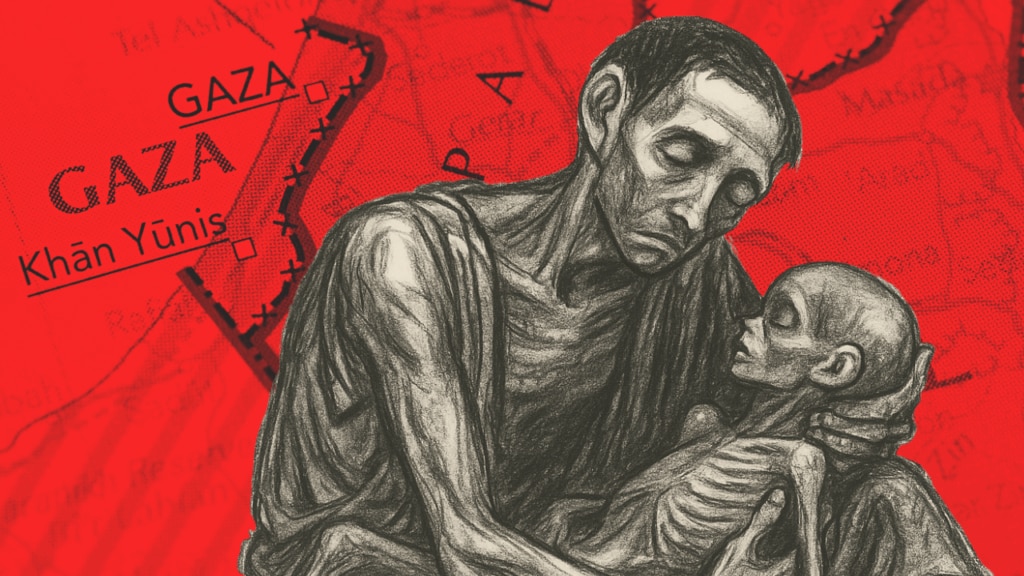Fazal Masood Malik & Farhan Khokhar, Canada

Seven-year-old Mai Abu Arar weighs far less than a healthy toddler. Once lively and joyous, she now takes only liquid food through a syringe in a Gaza hospital. She is among more than 500,000 Palestinians whom the UN-backed Integrated Food Security Phase Classification has declared to be experiencing famine. Yet hundreds of aid trucks laden with food sit idle at Gaza’s borders, just miles from the starving.
This proximity of salvation makes Gaza’s crisis uniquely cruel. The food exists. The trucks are loaded. The distribution networks could resume within hours. International donors have provided supplies. Aid workers stand ready. Every element needed to end the suffering waits at the borders. The IPC, which has declared only five famines since 2004, states unequivocally that this one “can be halted and reversed” immediately.
Gaza’s starvation differs fundamentally from historical famines in Sudan, Ethiopia, or Yemen, where vast distances, absent infrastructure, or active combat zones created genuine obstacles. There is no weather calamity or failure of crops. Here, the distance between food and the hungry can be measured in miles, sometimes in metres, an unfortunate situation that can only be described as “famine by design”; not the absence of solutions but their deliberate withholding.
The mechanism is precise. A functioning UN system of 400 community distribution points was replaced with just four sites run by the Gaza Humanitarian Foundation, an Israel-backed organisation. These militarised zones require Palestinians to traverse dangerous distances for food that could be delivered to their neighbourhoods. Since May, 994 Palestinians have been killed near these distribution points, most shot by Israeli forces.
The replacement system appears engineered for failure. Sites open briefly without notice. Recipients must pass military checkpoints, risking death for possible food. The model – likened to “feeding wild animals” – ensures the strong grab supplies while the vulnerable starve. Without tracking recipients, millions of meals are distributed, but no one knows who receives them, enabling diversion from families to armed groups, further leading to accusations of militants using food for themselves.
The math is straightforward. The UN calculates that a minimum of 600 daily trucks could meet basic needs. A fraction, about 36 as of this writing, is permitted. The shortfall is not capacity but permission. Medical supplies sit in warehouses. Potassium chloride, essential for treating malnutrition, waits at checkpoints. Every restricted truck represents a policy choice, not a logistical constraint.
Bread with conditions
Islamic tradition offers an unsettling parallel to Gaza City’s plight. The Prophet Muhammadsa warned of a time when the dajjal (Antichrist) would control sustenance: “With him will be mountains of bread, and people will be in distress except those who follow him.” The hadith continues with chilling relevance: “Whoever follows him, he gives him to eat, but also makes of him an unbeliever.” (Kanz al-Ummal [Arabic], 1981, Vol. 14, p. 325, Hadith 38819)
This prophecy finds eerie reflection in Gaza’s reality. Food exists in abundance, literal mountains of bread and supplies at the borders, while the population starves. The message is unmistakable: compliance brings sustenance, resistance brings hunger.
The parallel extends beyond metaphor. Just as the tradition describes people choosing between faith and food, Gazans face impossible choices: risk death at militarised distribution points, watch children starve, or abandon their land. The withholding of available sustenance becomes not merely a tactic but a test of will, a forced choice between survival and surrender.
The human cost
Behind each statistic lies preventable suffering. The Gaza health ministry reports 289 starvation deaths, including 115 children. These exclude those dying from infections that overwhelm malnourished bodies. Between 37 and 69 per cent of Gaza’s population faces emergency or catastrophe-level food insecurity – exceeding recorded peaks in South Sudan, Yemen, or Somalia.
Atef Abu Khater, 17, previously healthy, now lies dying from malnutrition. His father watches helplessly, having lost all income, unable to afford food that exists abundantly outside Gaza. Mohammed al-Mutawaq, 18 months old, suffers from severe malnutrition after his father was killed while seeking food. His mother, surviving on one daily meal when available, cannot produce milk. The formula exists in adjacent countries but cannot be shared across the border.
The brutal logic of survival destroys anyone who tries to defy it. Twenty-year-old Ahmadi Muslim, Mahmood Abu Awwad, was killed by an Israeli drone strike while gathering food to help the starving men, women and children around him, dying in the act of seeking the very sustenance that sits waiting at the borders. His death exemplifies the impossible trap: stay home and starve, or venture out for food and risk assassination from above.
Families report eating leaves while food trucks idle nearby. Hospital staff subsist on spoonfuls of rice while treating patients who seek intravenous glucose for hunger pangs. Parents face an impossible choice: risk death reaching militarised aid sites or watch children slowly starve while warehouses remain full miles away.
The proximity intensifies the cruelty. This is not remote suffering but starvation within sight of plenty. As one Gaza City resident explained, she lacks the strength to stand in aid lines while food that could be delivered safely sits at checkpoints.
Humanity denied
The withholding of available food violates principles predating modern law. Islamic jurisprudence explicitly forbids preventing access to food. Hazrat Abu Bakrra instructed armies: “Do not cut down fruit-bearing trees. Do not destroy an inhabited place.” (Al-Muwatta of Imam Malik, translated by Aisha Bewley, 2014, p. 329)
The Quran commands feeding the hungry as a sacred duty: “We feed you for Allah’s pleasure [only].” (Surah ad-Dahr, Ch.76: V:10) Similarly, during historical famines, Hazrat Umarra suspended some criminal punishments, recognising the power of desperation. (‘Umar ibn al-Khattab: His Life and Times, 2007, Vol. 1, pp. 421-422) In the current Israel-Palestinian war, the fact that food is available but withheld makes the current violations particularly cruel.
The seventh-century siege of Shi’b Abu Talib offers a historical parallel. Early Muslims, blockaded for three years, ate leaves while food existed outside their valley. Children’s hungry cries moved even enemies to secretly provide supplies. That such tactics were considered unconscionable fourteen centuries ago makes their modern deployment particularly damning.
Today’s nations are not merely bound by ancient moral codes but by explicit legal commitments. As signatories to the UN Charter’s Article 25 guaranteeing an adequate standard of living, and the International Covenant on Economic, Social and Cultural Rights, whose Article 11 recognises “the fundamental right of everyone to be free from hunger.” That starvation tactics deemed barbaric in the seventh century persist despite these binding treaties represents not progress but profound moral regression.
Institutional failure
International responses demonstrate rhetoric without action. Britain’s Foreign Secretary called the famine a “moral outrage” from Israel’s “refusal to allow sufficient aid.” The UN Secretary-General cited “unequivocal obligations under international law.” Yet convoys remain stationary, and Countries remain idle, with no more than lip service.
The United States, capable of ensuring aid delivery through diplomatic pressure, has remained notably silent since the famine declaration. The UN accepts Israeli restrictions, requiring permission for trucks which are hundreds of miles from Israeli forces. Aid agencies face the absurdity of being blamed for distribution failures while being denied distribution means.
Israel responds with familiar denial patterns: disputing numbers, blaming Hamas, and publicising images of uncollected aid. Officials claim that food is awaiting collection while preventing its distribution. They cite insufficient data from areas where they block data collection. None of these claims can contradict the eyewitness accounts of human catastrophe developing daily on the grounds of Gaza.
International law clearly defines “intentionally using starvation of civilians as a method of warfare” as a war crime. UN experts state resulting deaths may constitute wilful killing. Legal clarity exists; enforcement does not.
The immediate test of humanity
Every hour of delay while solutions sit ready represents a stark choice. The IPC warns that without implementation of available remedies, “avoidable deaths will increase exponentially.” The path forward requires no innovation: open crossings, restore distribution networks, and ensure safe passage. Trucks are fuelled. Drivers wait. Food will not spoil today or tomorrow.
We shall see whether international humanitarian law has any relevance when solutions are immediate and available. If half a million people can starve while food waits at borders, then the post-World War II or any semblance of a new order has collapsed not from inability but unwillingness of developed nations.
There will be a cost paid over centuries. Beyond individual suffering lies societal disintegration. Experts describe famine as “the death rattle of society.” Ireland’s Great Famine produced a century of silence. But Gaza’s trauma will be unique in the sense that rescue was always within reach, always possible, always withheld.
The “moral stain” will attach not only to those who restricted food but to those who could have insisted on its delivery. As scholars note, societies that inflict starvation create “ethics-free zones” where moral constraints dissolve. But Gaza represents something worse: the preservation of suffering when its relief requires only permission.
For all its perceived intricacies and false narratives, Gaza’s crisis is not complex. Food exists. Transport exists. Distribution networks can resume. Medical supplies await. The tragedy lies not in absence but in withholding, not in impossibility but in decision. If loaded trucks cannot travel a few miles to feed the starving, if available medicine cannot reach dying children, then humanitarianism has become performance art while humanity itself is denied.
The architecture of deliberate starvation being built in Gaza consists not of walls or weapons but of signatures withheld from permits that could be signed today. The mountains of bread foretold in prophecy sit at the borders, awaiting only the stroke of a pen to reach those who starve in their shadow. Is it not a famine by design?

